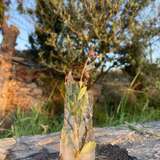Συμμετοχή στο διεθνή διαγωνισμό Young Reporters for the Environment
Το σχολείο μας ολοκλήρωσε, έναν κύκλο δράσεων που αφορούν στη μελέτη των περιβαλλοντικών και οικονομικών επιπτώσεων της κλιματικής κρίσης στην καλλιέργεια της ελιάς στην περιοχή της Μεσογείου (Κρήτη - Ανδαλουσία 2023-2024). Πραγματοποιήθηκαν εκπαιδευτικές εκδρομές στην περιοχή της Ανδαλουσίας, συζητήσεις με τοπικούς φορείς και έρευνα γύρω από το θέμα.
Τα αποτελέσματα μας καταγράφηκαν σε ένα άρθρο με το οποίο συμμετέχουμε στο διεθνή διαγωνισμό Y.R.E.. Επίσης συμμετέχουμε και στις κατηγορίες φωτογραφία ρεπορτάζ και φωτογραφία καμπάνιας.
Study of the environmental and economic effects of the climate crisis on olive cultivation in the Mediterranean region (Crete - Andalusia 2023-2024)
The cultivation of the olive tree in Crete, the southernmost island of Europe, began thousands of years ago and is one of the reasons for the economic prosperity of the Minoan civilization. But what is the connection between this Mediterranean island and the olive tree? And above all, what will its relationship be in the future, given the climate crisis?
The olive tree, which we all know, has certain characteristics that affect its ability to thrive. Such factors include the temperature range, water requirements, suitable soil and the olive harvest. According to Guillermo Rodríguez Gutiérrez, a professor of food chemistry at the Instituto de la grasa of the Pablo de Olavide University of Seville, the temperature at which olive trees thrive is between 21°C and 27°C, as this is where the fruit grows and ripens optimally. The professor explained to the students of our school, during our visit to the Institute, how an adequate water supply is essential for olive trees, especially at critical stages in the growth of the tree and thus of the fruit. Although they can tolerate short periods of drought, continuous and adequate irrigation is necessary for optimum yield. It is also worth noting that olive trees prefer well-drained, loamy soils for optimal growth and efficient access to nutrients.
In addition, the harvesting of olive fruit is an important part of agricultural work. In particular, olives are usually harvested from autumn to winter, depending on the variety of olive and the geographical area. Most regions in the Mediterranean, such as Crete and Andalusia, are harvested from October to February. As regards the ways in which harvesting is carried out, the two main ones are mechanical means and manual harvesting by man. Mechanical harvesting is considered to be more effective in large areas of olive groves, as it makes use of harvesting machinery. Manual harvesting, on the other hand, is used for traditional olive oil production.[1]
According to the general manager of the olive tourism company Basilippo, in Seville, Isaac Martín, apart from the process of harvesting and production of olive oil in terms of its sale on the market, it is available in five categories. Starting from the highest to the lowest quality, we distinguish it into: Extra virgin, virgin, ordinary olive oil, lampante olive oil and refined olive oil, of which the last two are not edible. The quality of olive oil depends on various factors, such as the climate, the composition of the soil, the variety of the olive fruit, the method of harvesting and the time of harvesting.[2]
Today 65% (2.350.000 hectares) of the island's agricultural area is olive groves, comprising at least 35.000.000 trees. In Crete, 80.000-120.000 tons of olive oil are produced annually, about 1/3 of the domestic production, of which 90% belongs to the category of extra virgin olive oil. In the last three years there has been a significant increase in the average price per kilo compared to the previous 30 years. This is due to lower production (down to around 60%) and is expected to continue.[3],[4] The same picture prevails in the world's largest oil-producing powerhouse, Spain. The official forecasts recently announced by the Minister of Agriculture in the Andalusian Region, Carmen Crespo,[5] put this year's olive oil production at 587,000 tons, down 49% on last year due to the drought. The economy of Crete and Andalusia is directly linked to olive growing. But what is the future of olive growing on our island and in the Mediterranean in general?
One of the effects of climate change is desertification, the drying of the land, to such an extent that the land is losing its vegetation and wildlife. Desertification is also caused by human over-exploitation of the soil. Geographically, the south-eastern part of Crete is threatened by desertification, since it belongs to the dry heat zone with little rainfall and high temperatures. Growing olives in such conditions will become increasingly difficult. Climate factors pose a threat to the quality of life of the people, who, unable to adapt to the new conditions, will be forced to migrate. According to recent UN figures, 21.5 million people have been displaced by weather events. Areas of Africa are in immediate danger due to desertification, fragile coastlines and the population's dependence on agriculture. Indeed, it is not unlikely that areas in Crete will also be at risk from climate migration.[6]
But it is not only Crete that is at risk. In the last 50 years, Andalusia has experienced mild winters and hot and dry summers. In the last 45 years, only four of them have had normal rainfall.[7] On average it rains only 30 days a year, which has a direct impact on crops, especially olives. This has a negative impact on the final production of olive oil. A study carried out at the University of Cordoba has shown that there will be a reduction in the area available for cultivation, which will have a direct impact on the local economy.
The strong effects of climate change, and within them the increase in greenhouse gas emissions, make it imperative that we act immediately. However, a collective effort in the fight against climate change and immediate action is required. It is important to switch to renewable energy sources and replace fossil fuels with other energy sources, such as solar and wind energy, thus reducingCO2 emissions. Then an important step is to improve the energy efficiency of buildings and internal combustion engines in cars and factories. Changes in farming with more sustainable methods, such as organic farming and reducing the use of fertilizers and pesticides, which are also related to olive growing, can also reduce emissions of nitrous oxide, a major greenhouse gas.
More generally, reversing climate change requires an integrated approach and cooperation at all levels of society if we are truly interested in creating a more sustainable and healthier future for future generations.
Sources:
[1] Instituto de la grasa
[2] Basilippo
[3] Υπουργείο Αγροτικής Ανάπτυξης & Τροφίμων
[4] Παραγωγή και τιμή ελαιολάδου
[5] Olive Oil Times
[6] European Soil Data Center - Ερημοποίηση
[7] Meteoblue


